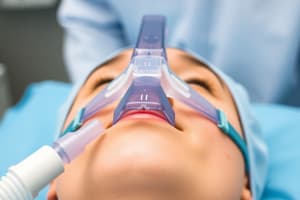Podcast
Questions and Answers
Which of the following respirators is NOT suitable for use in interior structural firefighting?
Which of the following respirators is NOT suitable for use in interior structural firefighting?
- Supplied-air respirator (SAR)
- N95 particulate respirator (correct)
- Half mask cartridge respirator
- Self-contained breathing apparatus (SCBA)
What is the primary purpose of using particulate respirators according to the guidelines?
What is the primary purpose of using particulate respirators according to the guidelines?
- To protect against carbon dioxide exposure
- To filter out harmful pathogens in the air (correct)
- To provide oxygen in oxygen-deficient environments
- To shield from all chemical exposure
Who certifies the respirators used during fire suppression by the Tulsa Fire Department for compliance with safety standards?
Who certifies the respirators used during fire suppression by the Tulsa Fire Department for compliance with safety standards?
- third party (correct)
- Federal Emergency Management Agency (FEMA)
- National Institute for Occupational Safety and Health (NIOSH)
- National Fire Protection Association (NFPA)
In which situations does the Tulsa Fire Department recommend the use of N95 respirators?
In which situations does the Tulsa Fire Department recommend the use of N95 respirators?
What type of atmospheres do N95 respirators NOT protect against?
What type of atmospheres do N95 respirators NOT protect against?
What is a necessary condition for using the high-efficiency cartridge/filter provided by the TFD?
What is a necessary condition for using the high-efficiency cartridge/filter provided by the TFD?
Which of the following conditions prohibits the use of half-mask respirators for firefighting?
Which of the following conditions prohibits the use of half-mask respirators for firefighting?
What type of contaminants can the TFD's half mask cartridge/filter specifically address?
What type of contaminants can the TFD's half mask cartridge/filter specifically address?
Why is it crucial to identify both the contaminant and its quantity before selecting a respirator?
Why is it crucial to identify both the contaminant and its quantity before selecting a respirator?
What is the primary reason the full and half-mask respirators are given to fire investigators and the Technical Rescue Team?
What is the primary reason the full and half-mask respirators are given to fire investigators and the Technical Rescue Team?
Under what circumstances are SCBAs specifically mandated for personnel?
Under what circumstances are SCBAs specifically mandated for personnel?
Which procedure is NOT a mandatory skill outlined in SCBA Skills Management section 200.3.6 “SCBA/respiratory protection skills”?
Which procedure is NOT a mandatory skill outlined in SCBA Skills Management section 200.3.6 “SCBA/respiratory protection skills”?
What is the primary function of SCBAs according to the guidelines?
What is the primary function of SCBAs according to the guidelines?
What does IDLH stand for in the context of SCBA usage?
What does IDLH stand for in the context of SCBA usage?
What is one of the mandatory procedures included in the SCBA/Respiratory Protection Skills management?
What is one of the mandatory procedures included in the SCBA/Respiratory Protection Skills management?
What is a critical limitation when using Supplied-Air Respirators (SARS)?
What is a critical limitation when using Supplied-Air Respirators (SARS)?
In which situations are Supplied-Air Respirators (SARS) most appropriately utilized?
In which situations are Supplied-Air Respirators (SARS) most appropriately utilized?
What type of teams primarily utilize Supplied-Air Respirators (SARS)?
What type of teams primarily utilize Supplied-Air Respirators (SARS)?
What must be used as a backup when wearing Supplied-Air Respirators (SARS)?
What must be used as a backup when wearing Supplied-Air Respirators (SARS)?
What is a key safety consideration regarding the air supply hose used with Supplied-Air Respirators (SARS)?
What is a key safety consideration regarding the air supply hose used with Supplied-Air Respirators (SARS)?
What kind of cartridge does the TFD use currently use?
What kind of cartridge does the TFD use currently use?
Flashcards
N95 Respirator
N95 Respirator
A NIOSH-approved respirator that protects against airborne pathogens like tuberculosis.
Cartridge/Filter Respirators
Cartridge/Filter Respirators
Respirators designed for firefighting, they protect against various hazards like chemicals, IDLH atmospheres, and combustion products.
Supplied-Air Respirators (SARs)
Supplied-Air Respirators (SARs)
A respirator that provides respiratory protection through a hose connected to a compressed air source.
Self-Contained Breathing Apparatus (SCBAs)
Self-Contained Breathing Apparatus (SCBAs)
Signup and view all the flashcards
Donning and Doffing
Donning and Doffing
Signup and view all the flashcards
Respirator Inspection
Respirator Inspection
Signup and view all the flashcards
Respirator Cleaning and Maintenance
Respirator Cleaning and Maintenance
Signup and view all the flashcards
Air Quality and Quantity Checks
Air Quality and Quantity Checks
Signup and view all the flashcards
Cascade/Fill Station
Cascade/Fill Station
Signup and view all the flashcards
Respiratory Protection Training
Respiratory Protection Training
Signup and view all the flashcards
IDLH Atmosphere
IDLH Atmosphere
Signup and view all the flashcards
Oxygen Deficiency
Oxygen Deficiency
Signup and view all the flashcards
Respirator Use
Respirator Use
Signup and view all the flashcards
Cartridge/Filter Respirators
Cartridge/Filter Respirators
Signup and view all the flashcards
Supplied Air Respiratory System
Supplied Air Respiratory System
Signup and view all the flashcards
Particulate Respirator
Particulate Respirator
Signup and view all the flashcards
SCBA (Self-Contained Breathing Apparatus)
SCBA (Self-Contained Breathing Apparatus)
Signup and view all the flashcards
Escape Pack
Escape Pack
Signup and view all the flashcards
Cascade System
Cascade System
Signup and view all the flashcards
Oxygen Deficient Atmosphere
Oxygen Deficient Atmosphere
Signup and view all the flashcards
SCBA Skills Management
SCBA Skills Management
Signup and view all the flashcards
Study Notes
Incident Safety - Respirator Selection
- Respirators must be NIOSH-approved and certified compliant with NFPA standards.
- TFD offers various respirators including N95s, cartridge/filter types, supplied-air respirators (SARs), and self-contained breathing apparatus (SCBAs).
Particulate Respirators
- N95 respirators are designated for use in atmospheres suspected to contain airborne pathogens like tuberculosis.
- N95s are unsuitable for firefighting due to their inability to protect against chemicals, IDLH atmospheres, or combustion products.
- The use of N95 respirators in IDLH situations is prohibited.
Cartridge/Filter Respirators
- Full and half-mask respirators are utilized by fire investigators and Technical Rescue Teams.
- Cartridges/filters are disposable and specific to contaminants; there is no universal filter for all airborne contaminants.
- TFD currently uses a high-efficiency organic vapor and acid gas filter under specific conditions: oxygen levels above 19.5%, non-IDLH atmospheres, and no known chemical hazards.
Supplied-Air Respirators (SARs)
- SARs are utilized by Hazmat and Technical Rescue Teams, ideal for environments requiring a high level of respiratory protection.
- They are effective in IDLH atmospheres but limit mobility due to the need to be within 300 feet of the air supply.
- A backup SCBA or escape pack is mandatory while using SARs.
Self-Contained Breathing Apparatus (SCBAs)
- SCBAs provide the highest level of respiratory protection and mobility.
- SCBAs are required in the following situations: exposure to smoke, carbon monoxide levels exceeding 35 ppm, known or suspected IDLH atmospheres, and potentially contaminated atmospheres.
SCBA Skills Management
- Mandatory procedures include donning/doffing, use, inspection, cleaning, and maintenance of respirators.
- Procedures for air quality, quantity checks, and cascade/fill station operation are also essential.
- Respiratory protection training is required for TFD personnel to ensure safety and compliance.
Studying That Suits You
Use AI to generate personalized quizzes and flashcards to suit your learning preferences.




